When in 1342 Pierre Roger de Beaufort sat on the throne of Peter as Clement VI, he was said to have said to his entourage:"Before me no one knew how to be pope." And indeed - soon the world saw with his own eyes what his words meant ...
Clement's predecessors could live lavishly and debauchery, but probably no one suspected that… it could be even worse. It soon turned out, however, that the new holy father had a very simple recipe for holding the pontificate - he intended to derive unfettered joy from the riches and position that the papal tiara had given him.
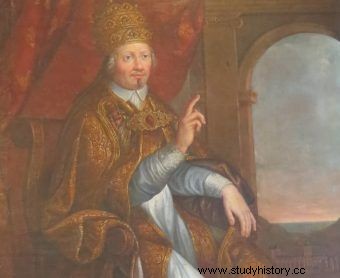
Pope Clement VI enjoyed the privileges of his position without hesitation.
And it already started with a pontifical feast attended by 300 eminent guests. Over 200 barrels of wine poured in streams, tables were swayed under the weight of sophisticated meat dishes, and many thousands of cakes were even ashamed to mention. Such a start to rule must have aroused both admiration and disgust.
Papal Byzantium
The inaugural feast was only an introduction to the further debauchery of the successor of St. Peter. Clement, despite the efforts of theologians and the Roman delegation, had no intention of returning to the Eternal City. He dreamed of complete independence from the curia. To ensure a permanent place of residence, he bought the city of Avignon, which he had leased so far, from the Queen of Naples, Joan I.
Soon the Avignon palace, generously financed from the papal treasury, became one of the finest examples of secular architecture of the Gothic era. The most expensive tapestries and silks hung on the walls, and immodest frescoes with frolicking nymphs and satyrs adorned entire rooms. The malicious people said that the horses of the holy father wore saddle pads made of gold, although in fact only their bridles were made of the precious metal ...
Yes, Clement VI loved to spend money and he was able to shower even the greedy petitioners with more than they dared to ask. And there were never enough people willing to take advantage of his motto, which said that "the pope should make his subjects happy", there was never a lack of people. Apart from the usual tricksters and flatterers, the city on the Rhone also attracted numerous poets, painters, musicians, architects and sculptors. The head of the Church with his generous hand supported the artists who never complained about the excess of cash, closing the mouths of his patronage to the malcontents who pointed out to him the glitter of the Avignon court.
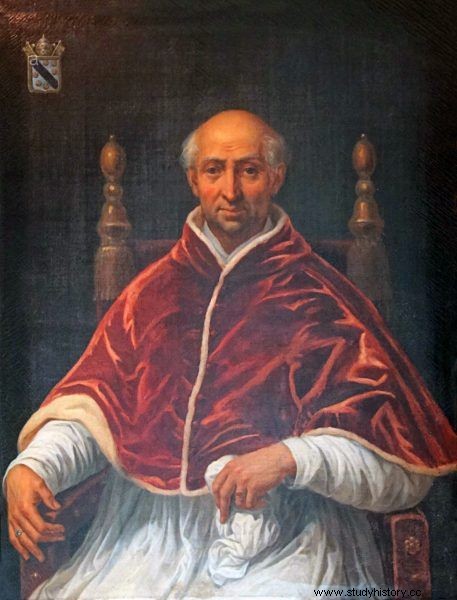
Clement wore truly imperial. For his own needs he bought golden fabric from Syria, Tuscan silk and delicate linen from Reims, Paris and Flanders.
Clement himself wore truly imperial. For his own needs, he imported golden fabric from Syria, Tuscan silk and delicate linen from Reims, Paris and Flanders. He also liked perfectly dressed furs - a luxury reserved for the richest and most dignified citizens of the time. In the notes of the papal chancellery you can find an annotation about the use of over 1220 ermine skins - a momentum worthy of Byzantium!
(Un) clean
The Holy Father loved not only to eat well and look good - he also liked to have fun. Of course, in the company of women ... According to the messages, banquets attended by numerous ladies were a normal sight in the palace. Their presence was not limited only to the dining room - because the papal bedroom was also open to them. According to chroniclers, Klemens:
when he was an archbishop, he did not shy away from women, following the fashion of young nobles [...], as the pope did not limit his aspirations.
Avignon was buzzing with rumors of Clement's extraordinary intimacy with Cecilia, Countess of Turenne. She was even to perform the duties of a housewife in the property of the head of the Church, and a large part of the favors distributed by the Pope passed through her hands.
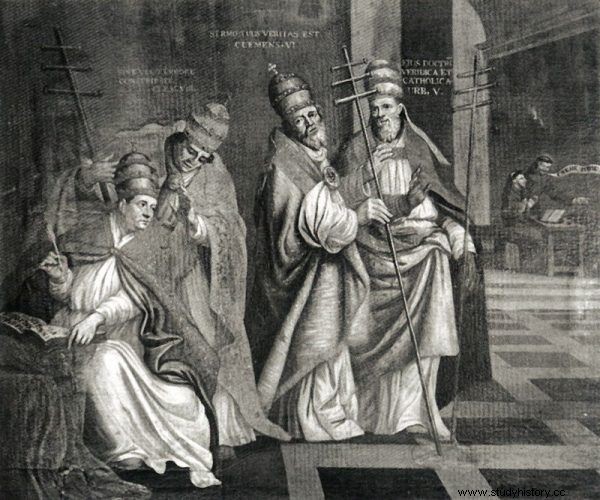
photo:public domain of Four Popes:Innocent VI, Clement VIII, Clement VI and Urban V.
Even if this slander (the preserved letters do not indicate that Cecylia was in fact a papal concubine), it was a fact that the debauchery of the Avignon court had become a custom. After each vespers, Clement VI met with women, often with several at a time. Scandalized, Petrarch wrote:
I won't talk about adultery, seduction, rape, incest; it's just a prelude to an orgy. I won't count seduced wives and girls without virginity. I will not talk about the ways in which the silence of offended husbands and fathers is made, nor about the wickedness of those who sell their women for gold.
The enormity of the indecency worthy of Sodom and Gomorrah even prompted the papal confessor to try to convert Clement to the path of purity. However, he replied that he was taught to sleep with women when he was young, and now, on the advice of medics, he was not going to give up this practice. However, he soon failed to follow medical advice.
Find out more:In the mid-16th century, another pope began a relentless fight against prostitution. How did this battle end?
If you are afraid, go to God
In 1348, the "Black Death", brought from the East, arrived in Avignon. The plague that ravaged Italy last year killed 1,800 people in the first days. Each next day brought nearly 400 victims, which, due to the lack of places in the cemeteries, were thrown into the Rhone consecrated by the Pope.
Many church officials and ordinary residents left the city looking for help in nearby villages. They had no idea that they were thus contributing to the spread of the plague faster. At the same time, everyone probably expected that the successor of St. Peter will take his feet by the belt. How astonished they must have been to find Clement staying in Avignon.
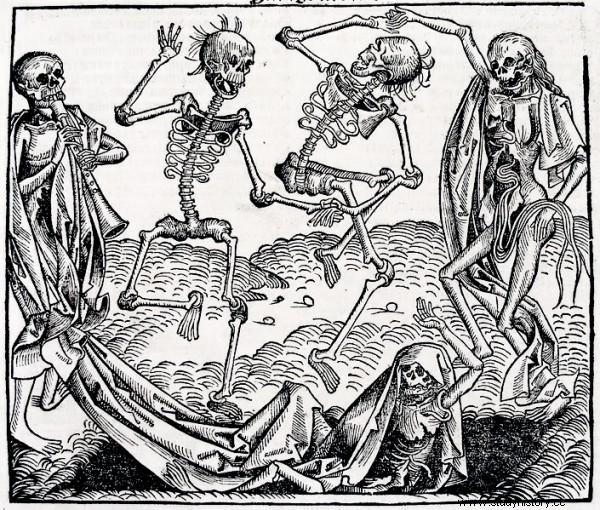
A dance of death inspired by the plague.
Probably terrified by the scale of the epidemic, he listened to the explanations of astrologers who saw its causes in the unfavorable conjunction of Saturn, Jupiter and Mars. In search of the source of the disease, he also allowed medics to perform an autopsy - a thing that aroused the hard resistance of theologians. On the other hand, following the doctors' advice, he opted for isolation and locked himself in palace chambers, additionally surrounded by large fires to protect against infection. Thanks to this, fleas (responsible for spreading the plague, but it was not known then), avoiding heat, did not enter the papal court.
Clement also took seriously the opinions of critics that the plague was a punishment for the immorality of the Avignon court. At that moment there was a radical transformation of the dissolute pope - after all, how fear is to God! Carnal pleasures were forgotten, and pious processions, including flagellants, appeared in the streets. It was said that the Pope himself was attending.
Soon the movement of flagellants, believing that by self-harming they would soothe God's wrath and set the world free from the plague, got out of control. Their frightening processions were banned by a papal bull in 1349. Penitential practices were to be limited to church services, listening to sermons about the inevitability of God's justice, fasting, and supporting the living and dead victims of the epidemic. Clement also granted an Easter indulgence to all those who, after confessing and showing repentance, will die of the plague.
Interestingly, despite the fear of contagion, the pope did not completely give up meetings with the faithful. Whenever possible, he tried to help desperate people, sparing no gold from his treasury.
The guilty party will always be found
Unfortunately, in addition to the bloody harvest of victims of the disease itself, the plague had another tragic result. Faced with the futility of searching for the causes of the plague, the alleged perpetrators of the plague were found - not for the first time:the Jews. They were attributed, among other things, to poisoning the wells, which allegedly contributed to the spread of the disease.
Soon there were nearly 300 pogroms in Europe, and in Mainz alone, 6,000 Jews were ruthlessly slaughtered during the riots. The problem became so great that Clement VI issued two bulls in 1348 condemning the organizers of lynchings. At the same time, he called on the clergy to oppose similar practices. He also emphasized that Jews deserved the same support during the plague as Christian victims.
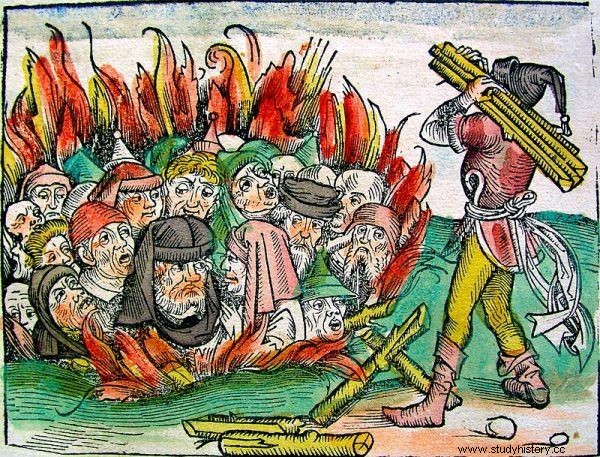
photo:public domain Burning alive Jews accused of spreading the plague.
Clement survived the plague, and his terrible experiences made him change his attitude towards the popes' return to Rome. He even began to prepare for it, but never made it to the Eternal City - he died in Avignon on December 6, 1352.
His heroic - for those times - attitude and inner transformation did not find understanding. When the Avignon bells sounded, announcing the death of the Holy Father to the world, people cheered: He is dead! The Pope is dead, he is already in hell! ” . In the Basilica of St. Peter was reportedly struck by lightning. And even when fifty priests celebrated Mass for the peace of Clement's soul for nine consecutive days, there were no shortage of spitefuls saying:"Nothing will help him anymore."
Bibliography:
- Catholic Encyclopedia [access:2/10/2020].
- Cawthorne N., The Sexual Life of Popes , crowd. M. Rogowski, Katowice 2000.
- Duda S., The Pope who feared God , "Gazeta Wyborcza" from April 20, 2020, "Ale Historia" no. 94.
- Norwich J.J., Extraordinary stories of popes , crowd. A. Żukowska-Maziarska, Warsaw 2012.
- Stadler H., Lexicon of Popes and Councils , crowd. M.L. Kalinowski, M. Struczyński, B. Tarnas, Warsaw 1992.
- Wood D., Clement VI:The pontificate and ideas of an Avignon pope , Cambridge 1989.
